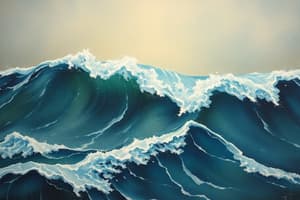Podcast
Questions and Answers
What are the primary components of longitudinal waves?
What are the primary components of longitudinal waves?
- Speed and frequency
- Crests and troughs
- Amplitude and wavelength
- Compressions and rarefactions (correct)
What physical property describes the number of compressions that pass a point in one second?
What physical property describes the number of compressions that pass a point in one second?
- Wave speed
- Wavelength
- Frequency (correct)
- Wave period
How does pitch relate to frequency?
How does pitch relate to frequency?
- Pitch is unrelated to frequency
- Higher pitch corresponds to lower frequency
- Higher pitch corresponds to higher frequency (correct)
- Pitch depends solely on amplitude
What describes the amplitude of sound waves?
What describes the amplitude of sound waves?
Which type of wave travels through a vacuum?
Which type of wave travels through a vacuum?
How is the wavelength of a longitudinal wave defined?
How is the wavelength of a longitudinal wave defined?
What is a characteristic of sound waves?
What is a characteristic of sound waves?
Which two properties of waves are inversely related?
Which two properties of waves are inversely related?
Which among these may be considered a mechanical wave?
Which among these may be considered a mechanical wave?
Pitch is a property of sound that highlights?
Pitch is a property of sound that highlights?
The distance between two succeeding crests of a wave is known as?
The distance between two succeeding crests of a wave is known as?
The property of light which allows it to change speed upon passing through different media is called?
The property of light which allows it to change speed upon passing through different media is called?
Wavelength and frequency are ____________ to each other?
Wavelength and frequency are ____________ to each other?
What is the relationship between wavelength and frequency for wave speed?
What is the relationship between wavelength and frequency for wave speed?
What defines the period of a wave?
What defines the period of a wave?
In which medium does sound travel the fastest?
In which medium does sound travel the fastest?
What happens to the speed of light when it enters a denser medium?
What happens to the speed of light when it enters a denser medium?
If a wave has a wavelength of 19.21 meters and a speed of 331.45 m/s, what is the frequency?
If a wave has a wavelength of 19.21 meters and a speed of 331.45 m/s, what is the frequency?
What do crests and troughs of a transverse wave represent?
What do crests and troughs of a transverse wave represent?
What describes the phenomenon of refraction?
What describes the phenomenon of refraction?
Which statement about mechanical waves is true?
Which statement about mechanical waves is true?
What is the incident angle (α) in relation to light?
What is the incident angle (α) in relation to light?
What happens to light when it passes through a prism?
What happens to light when it passes through a prism?
Which color of light has the longest wavelength?
Which color of light has the longest wavelength?
What is a crest in wave terminology?
What is a crest in wave terminology?
Which type of wave travels parallel to the direction of the initial force?
Which type of wave travels parallel to the direction of the initial force?
What characterizes a wave's trough?
What characterizes a wave's trough?
What can be said about mechanical waves?
What can be said about mechanical waves?
What does the absence of matter represent in wave propagation?
What does the absence of matter represent in wave propagation?
Flashcards
Longitudinal wave
Longitudinal wave
A wave that travels in a direction parallel to the direction of the vibrating particles.
Compression
Compression
A part of a longitudinal wave where particles are closer together; a decrease in volume.
Rarefaction
Rarefaction
A part of a longitudinal wave where particles are further apart; an increase in volume.
Wavelength (λ)
Wavelength (λ)
Signup and view all the flashcards
Frequency (f)
Frequency (f)
Signup and view all the flashcards
Period (T)
Period (T)
Signup and view all the flashcards
Pitch
Pitch
Signup and view all the flashcards
Loudness
Loudness
Signup and view all the flashcards
Transverse Wave
Transverse Wave
Signup and view all the flashcards
What is wavelength?
What is wavelength?
Signup and view all the flashcards
What is frequency?
What is frequency?
Signup and view all the flashcards
What is wave speed?
What is wave speed?
Signup and view all the flashcards
Mechanical wave
Mechanical wave
Signup and view all the flashcards
Electromagnetic wave
Electromagnetic wave
Signup and view all the flashcards
What is refraction?
What is refraction?
Signup and view all the flashcards
What is the speed of light in a vacuum?
What is the speed of light in a vacuum?
Signup and view all the flashcards
Incident Angle (α)
Incident Angle (α)
Signup and view all the flashcards
Refracted Angle (β)
Refracted Angle (β)
Signup and view all the flashcards
Refractive Index
Refractive Index
Signup and view all the flashcards
Inverse Relationship
Inverse Relationship
Signup and view all the flashcards
Longest Wavelength
Longest Wavelength
Signup and view all the flashcards
Highest Frequency
Highest Frequency
Signup and view all the flashcards
What kind of wave is sound?
What kind of wave is sound?
Signup and view all the flashcards
What is pitch?
What is pitch?
Signup and view all the flashcards
What is amplitude?
What is amplitude?
Signup and view all the flashcards
Study Notes
Waves and Their Properties
- Waves are propagating dynamic disturbances that travel between vibrating and oscillating fields.
- Waves contain crests (upper points) and troughs (lower points).
- Waves can exhibit different behaviors depending on how they travel and propagate.
- Examples include surface water waves, light, sound, and specific types of motion.
Sound
- Sound is vibrations traveling through air or other mediums.
- Humans and animals can hear sound when it reaches their ears.
- Sound is produced when matter vibrates within a medium.
- Sound waves travel in a direction parallel to the source's path.
Longitudinal Waves
- Longitudinal waves travel in a direction parallel to the material's action.
- They consist of compressions (closer particles, decrease in volume) and rarefactions (particles spread out, increase in volume).
Properties: Longitudinal Waves
- Wavelength (λ): distance between two successive compressions.
- Frequency (f): number of compressions passing through a point per second.
- Period (T): time taken for one full vibration.
Properties of Sound
- Pitch: perception of sound frequency by the human ear. Higher pitch means higher frequency, lower pitch means lower frequency.
- Loudness: perception of sound wave amplitude. Amplitude is a measure of the maximum disturbance of sound. Amplitude can also be described as the height of a crest/trough in relation to the wavefront.
Light
- Light is radiation traveling through a medium (or a vacuum).
- Light allows objects to be visible.
- Light consists of waves that can travel through a vacuum.
- Light propagates through oscillating electric and magnetic fields at perpendicular directions.
Transverse Waves
- Transverse waves travel in a direction perpendicular to the material's action.
- Transverse waves contain crests (high points) and troughs (low points).
- Crests are treated like compressions, and troughs like rarefactions.
Properties: Transverse Waves
- Wavelength: distance between two successive crests or troughs.
- Frequency: number of full waves that pass through a point in a second.
- Period: time taken for one full vibration.
Speed of a Wave
- Waves travel at different speeds based on their wavelengths (λ) and frequencies (f).
- Speed (v) = wavelength (λ) x frequency (f) (v = λf)
- Period (T) = 1 / frequency (f) (T = 1/f)
Wave Speed Calculations
- Example calculation 1: A wave with 32.75 Hz frequency and 12.50m wavelength has a speed of 409.38 m/s.
- Example calculation 2: A sound wave traveling at 331.45 m/s and 17.25 Hz frequency has a wavelength of 19.21 meters.
- Example calculation 3: A wave traveling at 85.64 m/s and 972 cm (9.72 m) length has a frequency of 8.81 Hz.
- Example calculation 4: A wave traveling at 67.65 m/s and 1385 dm (138.5 m) length has a period of 2.05 seconds.
Mechanical Waves
- Mechanical waves travel through different mediums, but cannot travel through a vacuum.
- Sound waves are mechanical waves needing a solid, liquid, or gas medium to travel.
- Sound waves travel fastest in solids, slowest in gases.
- Sound travels faster in higher temperatures.
Light as a Wave
- Light waves propagate through interchanging electric and magnetic fields rather than matter oscillations.
- Electric and magnetic fields exist in planes even without a medium.
- Light can travel through a vacuum.
Electromagnetic Waves
- Electromagnetic waves propagate in the presence or absence of a medium.
- Visible light is an electromagnetic wave that travels through a vacuum at 299,792,458 m/s (3x108 m/s).
- The speed of light waves decreases as they enter a denser medium.
- When light travels through different media the speed changes, this is called refraction.
Refraction
- Refraction is a change in speed when waves pass through different optical densities.
- In refraction diagrams the incident angle (α), the angle at which light strikes an object or medium with respect to the normal line, and the refracted angle (β), the angle formed after light bends due to the change in optical density, are shown.
Colors of Light
- Visible colors of light each have their own refractive index.
- When white light passes through a prism it separates into various component colors.
- Colors have different speeds and corresponding wavelengths.
Frequency and Wavelength
- Red light has the longest wavelength and lowest frequency.
- Violet light has the shortest wavelength and highest frequency.
- Wavelength and frequency have an inverse relationship.
Short Quiz Questions and Answers
- Question 1: Wave (B).
- Question 2: Crest (A).
- Question 3: Longitudinal (D).
- Question 4: Trough (B).
- Question 5: Transverse (C).
- Question 6: Vacuum (D).
- Question 7: Mechanical (A).
- Question 8: Sound (B).
- Question 9: Frequency (C).
- Question 10: Amplitude (A).
- Question 11: Frequency (C).
- Question 12: Wavelength (B).
- Question 13: Refraction (C).
- Question 14: Incident (A).
- Question 15: Inversely Related (B).
Part II: Arrangement
- Arrange colors of light with respect to highest to lowest frequency.
- Arrange colors of light with respect to longest to shortest wavelength.
Part III: Solve It
- A radio wave traveling through a vacuum with a 1.5 kHz frequency has a wavelength of approximately 200,000 meters.
Studying That Suits You
Use AI to generate personalized quizzes and flashcards to suit your learning preferences.




